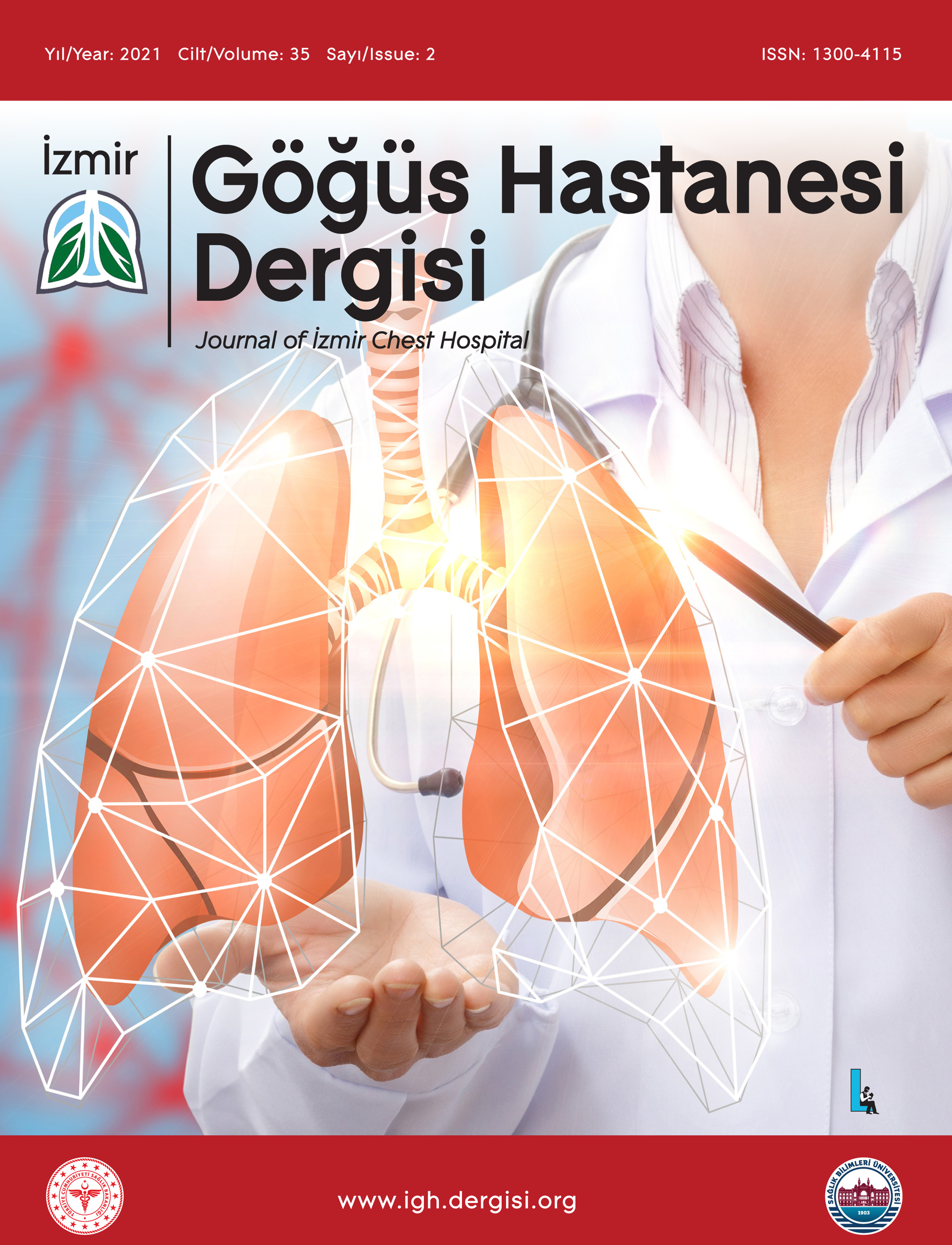Bronşektazi Şiddeti İndeksi ve FACED Skorlaması Kullanılarak Bronşektazide Hastaneye Yatış, Alevlenme ve Mortalite Öngörüsü
Sertan Bulut1, Harun Karamanlı1, Deniz Çelik21Ankara Atatürk Sanatoryum Eğitim ve Araştırma Hastanesi, Göğüs Hastalıkları Kliniği, Ankara, Türkiye.2Alanya Alaaddin Keykubat Üniversitesi Eğitim ve Araştırma Hastanesi, Göğüs Hastalıkları Anabilim Dalı, Antalya, Türkiye
Amaç: Bronşektazi çok boyutlu ve etyolojik olarak farklı bir hastalıktır ve sonuç olarak, genel şiddetini ve prognozunu belirlemek için tek bir referans kullanılamaz. Bu çalışmada, mortalite, alevlenme ve hastaneye yatışlar için doğrulanmış iki farklı sonuç olan bronşektazi şiddeti değerlendirme anketlerinin [Bronşektazi Şiddeti İndeksi (BSI) ve FACED] karşılaştırılması amaçlandı.
Gereç ve Yöntemler: BSI ve FACED puanlarının hesaplanabildiği nonkistik fibrozis bronşektazili 107 denek için tıbbi kayıtlar geriye dönük olarak incelendi. Parametreler ile BSI veya FACED skoru arasındaki korelasyonlar değerlendirildi ve BSI ve FACED puanının bağımsız olarak ilişkili değişkenlerini tanımlamak için doğrusal bir regresyon analizi yapıldı.
Bulgular: FACED ve BSI ortalama puanları sırasıyla 3,5±1,9 ve 9,8±4,7 olarak belirlendi. FACED ve BSI skorları arasında istatistiksel olarak anlamlı bir ilişki bulundu (p<0,0001). Pearson Chi-Square (p=0,0001), tau-b de Kendall (0,59; p=0,0001). Kappa testi ile iki ölçek arasında %60,7 benzerlik gösterildi (p<0,0001). Alevlenmeler için BSI ve FACED, 0,758 ve 0,755 ROC eğrisi (AUC) bir değer gösterdi; hastane yatışı için ise sırasıyla 0,864 ve 0,597 değerleri tespit edildi. BSInın duyarlılığı FACED derecelendirmesinden daha yüksektir (%86ya karşı %59).
Sonuç: İki ölçek arasındaki korelasyon istatistiksel olarak anlamlı olmasına rağmen, hastalar FACED skoruna göre daha yüksek bir BSI puanı alma eğilimindeydi. BSI, sağlık sistemlerinde ölüm, hastaneye yatış ve alevlenme riski olan hastaları tanımlamak için yararlı bir klinik tahmin aracıdır.
Predicting Hospitalization, Exacerbation and Mortality in Bronchiectasis Using Bronchiectasis Severity İndex and FACED Scores
Sertan Bulut1, Harun Karamanlı1, Deniz Çelik21Department of Pulmonology, Ankara Atatürk Sanatory Training and Research Hospital, Ankara, Türkiye2Department of Pulmonology, Alanya Alaaddin Keykubat University Training and Research Hospital, Antalya, Türkiye
Objective: Bronchiectasis (BC) is a multifaceted and etiologically diverse condition and, as a result, no single endpoint can be used to determine its general severity and prognosis. Two different validated scores are currently being used to evaluate the seriousness bronchiectasis: The bronchiectasis severity index (BSI) and the FACED score. It is aimed at comparing the bronchiectasis severity assessment questionnaires whichs are two different validated outcomes for mortality, exacerbation, and hospitalizations.
Material and Methods: Medical records for 107 subjects with NCFB, for which BSI and FACED scores could be calculated, were reviewed retrospectively. The correlations between the parameters and the BSI or FACED score were evaluated and a linear regression analysis was conducted to identify the independently associated variables of the BSI and FACED score.
Results: The mean scores of FACED and BSI were 3.5±1.9 and 9.8±4.7, respectively. A statistically significant relationship was found between the FACED and BSI scores (p<0.0001), Pearson Chi-square (p=0.0001), and tau-b de Kendall (0.59; p=0.0001). It was showed a 60.7% similarity between the two scales by Kappa test (p<0.0001). BSI and FACED reported an area under ROC curve (AUC) for exacerbations of 0.758 and 0.755; and for hospitalizations (due to BE exacerbations) of 0.864 and 0.597, respectively. The sensitivity of the BSI is higher (86% versus 59%) than the FACED rating.
Conclusion: Patients tended to obtain a higher BSI score relative to the FACED score, although the correlation between the two scales was statistically significant. BSI is a helpful clinical predictor tool for identifying patients at risk of death, hospitalization, and exacerbation in health-care systems.
Makale Dili: İngilizce






